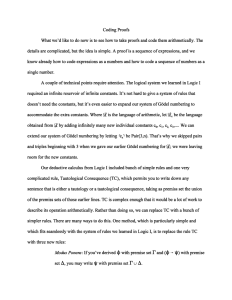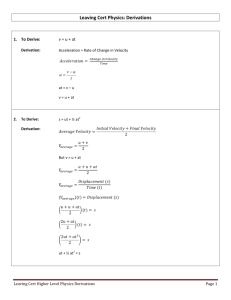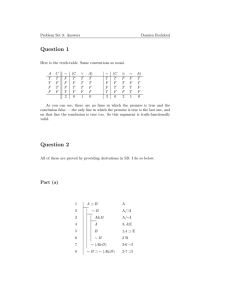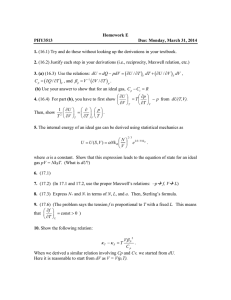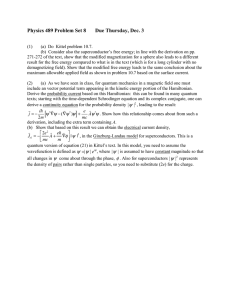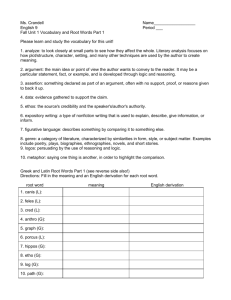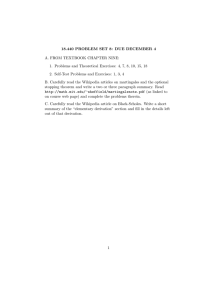Derivations in the Sentential Calculus
advertisement
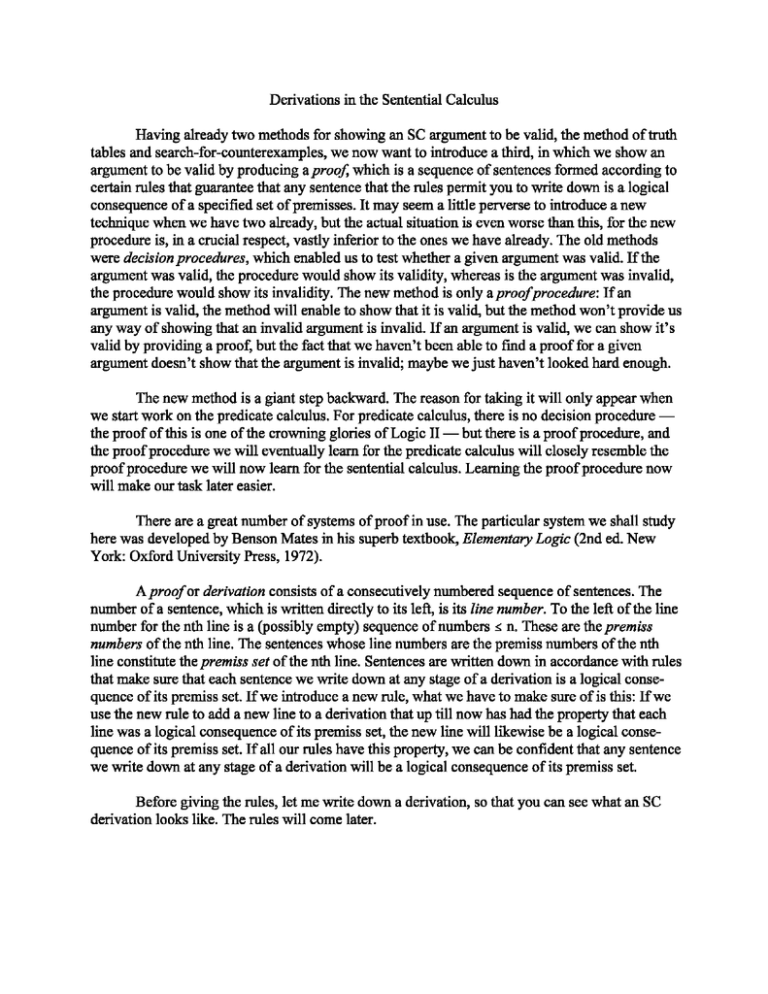
Derivations in the Sentential Calculus
Having already two methods for showing an SC argument to be valid, the method of truth
tables and search-for-counterexamples, we now want to introduce a third, in which we show an
argument to be valid by producing aprooJ which is a sequence of sentences formed according to
certain rules that guarantee that any sentence that the rules permit you to write down is a logical
consequence of a specified set of premisses. It may seem a little perverse to introduce a new
technique when we have two already, but the actual situation is even worse than this, for the new
procedure is, in a crucial respect, vastly inferior to the ones we have already. The old methods
were decisionprocedures, which enabled us to test whether a given argument was valid. If the
argument was valid, the procedure would show its validity, whereas is the argument was invalid,
the procedure would show its invalidity. The new method is only aproofprocedure: If an
argument is valid, the method will enable to show that it is valid, but the method won't provide us
any way of showing that an invalid argument is invalid. If an argument is valid, we can show it's
valid by providing a proof, but the fact that we haven't been able to find a proof for a given
argument doesn't show that the argument is invalid; maybe we just haven't looked hard enough.
The new method is a giant step backward. The reason for taking it will only appear when
we start work on the predicate calculus. For predicate calculus, there is no decision procedure the proof of this is one of the crowning glories of Logic I1 -but there is a proof procedure, and
the proof procedure we will eventually learn for the predicate calculus will closely resemble the
proof procedure we will now learn for the sentential calculus. Learning the proof procedure now
will make our task later easier.
There are a great number of systems of proof in use. The particular system we shall study
here was developed by Benson Mates in his superb textbook, Elementary Logic (2nd ed. New
York: Oxford University Press, 1972).
Aproof or derivation consists of a consecutively numbered sequence of sentences. The
number of a sentence, which is written directly to its left, is its line number. To the left of the line
number for the nth line is a (possibly empty) sequence of numbers < n. These are thepremiss
numbers of the nth line. The sentences whose line numbers are the premiss numbers of the nth
line constitute thepremiss set of the nth line. Sentences are written down in accordance with rules
that make sure that each sentence we write down at any stage of a derivation is a logical consequence of its premiss set. If we introduce a new rule, what we have to make sure of is this: If we
use the new rule to add a new line to a derivation that up till now has had the property that each
line was a logical consequence of its premiss set, the new line will likewise be a logical consequence of its premiss set. If all our rules have this property, we can be confident that any sentence
we write down at any stage of a derivation will be a logical consequence of its premiss set.
Before giving the rules, let me write down a derivation, so that you can see what an SC
derivation looks like. The rules will come later.
SC Derivations, p. 2
1
1
3
2,3
2
2
TI31
1.--P
2.(----P---P)
3. - P
4.---P
5.(-P---P)
6. P
7. (- P P)
PI
CP, 1
PI
MT, 2,3
CP, 3,4
MT, 1,5
CP, 1,6
--
The boldface "TH1" in the bottom left isn't a premiss number, and, in fact, it isn't a part of the
derivation at all. It's a bookkeeping notation for keeping track of the things we've proved. I am
keeping a tally, which is on the last page of this chapter.
Now for the rules. The governing principle in devising the rules is to make sure that, at
each stage of a derivation according to the rules, the sentence we write down is a logical
consequ&ce of its premiss set. Thifirst four rules only involve the connectives "-"and "-," and
they suffice to capture all the valid arguments that only involve these two connectives. If I? is a
set of SC sentences and cp an SC sentence that contain no connectives other than "-" and "-," cp
is a logical consequence of I? if and only if there is a derivation by the four rules of cp whose
premiss set is included in r. Thus the derivation above will show that "(- P P)" is a logical
consequence of the empty set, that it, that it is valid. Later, we'll add rules for the other
connectives.
--
Premiss Introduction Rule (PI). You may write down any sentence you
like if you take the sentence as its own premiss set.
Obviously, anything you write down by rule PI will be a logical consequence of its premiss set,
since a sentence is a consequence
of itself. One use of rule PI is simuly to let us write down the
premisses of our argument. Other, more technical uses, will emerge.
Our next rule gives us a method for proving a conditional: To prove a conditional,
assume the antecedent as a premiss, then try to derive the consequent. This will be the central
strategy for almost all our proofs.
Conditional Proof Rule (CP). If you have derived $ with premiss set r,
you may write ( 4 $) with premiss set I? {cp}.
-
-
-
Rule CP is logical-consequence preserving, since, if $ is a logical consequence of I?, then ( 4
$) is a logical consequence of r {cp}. Most of the time, when we apply CP, the antecedent cp
will be an element of the premiss set r, and the effect of the rule is to reduce the size of the
premiss set. Occasionally, we'll apply the rule when cp isn't an element of this is what we did
in line 2 of the derivation above. Such applications are legitimated by the fact that a conditional
is a consequence of its consequent.
-
SC Derivations, p. 3
- -
A simpler illustration of the two ways of employing CP is the following derivation of "(P
(Q P))":
PI
CP, 1
CP, 1,2
Sentences like this that we derive ffom the empty set are called SC theorems or theorems of
logic. Any such theorem is logically valid.
Modus Ponens Rule (MP). If you have derived cp with premiss set r and
(cp $) with premiss set A, you may write $ with premiss set r u A.
-
--
Modus Tollens Rule (MT). If you have derived $ with premiss set I? and
(- cp
$) with premiss set A, you may write cp with premiss set r u A.
-
--
Clearly, if cp is a logical consequence of I? and (cp $) is a consequence of A, $ is a
consequence of u A, and furthermore, if $ is a consequence of I? and (- cp
$) is a
consequence of A, cp will be a consequence of r u A.
- - -
As an example, let us derive the so-called principle of the syllogism,"((P
((Q R) (P R)))," from the empty premiss set.
- Q)
PI
PI
PI
m,193
m,2,4
CP, 3,5
CP, 2,6
CP, 1,7
This derivation illustrates our standard strategy for proving conditionals: Assume
the antecedent and try to derive the consequent. Once you have it, you can use CP to
remove the antecedent from the premiss set. As another example of the same strategy,
let's derive "((P (Q R)) (Q (P R)))" ffom the empty premiss set. We begin by
assuming the antecdent, hoping to fill the missing space in the following derivation:
- - - - -
1
- -
n. (Q (P R))
n+l. ((P- (Q R))
- -
(Q- (P- R)))
CP, 1, n
SC Derivations, p. 4
Again, the thing we're trying to prove is a conditional, and we prove it by assuming the
antecdennt and deriving the consequent:
SC Derivations, p. 5
1,2
1
n-1. (P- R) n.
(Q 0'
1 . (
P
+
In trying prove "(P
derive "R":
1
2
3
-
+
R))
-
Q
Q
R)," we follow the standard strategy, assuming "P" and trying to
1. (P-(Q-R))
2.
Q
3.
P
.........................................................
1,2,3 n-2.
R
1,2
n-1. (P- R)
1
n.
(Q 0' R))
n+l (((P (Q R))
- - - - +
CP, 2, n- 1 CP,l,n
+
(Q (P R)))
PI
PI
PI
CP, 3, n-2
CP, 2, n- 1
CP, 1, n
Now that we've gotten this far, we can complete the proof by filling in a couple of steps
of modus ponem:
.
3
3.
P
PI
1,2
4.
(Q-R)
m,1,3
1,2,3 5 .
R
m,2 , 4
1,2
6. (P-R)
CP, 3,5
7.
(Q (P+ R))
CP, 2,6
1
TH4 8. (((P (Q R)) (Q (P R))) CP, 1
- - - - +
Our first derivation was the principle of double negation elimination,
P)." Now let's derive the converse principle of double negation introduction:
PI
PI
CP, 2
PI
MT, 3,4
CP, 4,5
MT, 2,6
CP, 2,7
MT, 1,8
"(7
-P
SC Derivations, p. 6
Looking at this proof, we see that lines 2 through 9 are exactly like the proof of TH1,
except that "P"has been replaced everywhere bu 'GP." This exemplifies a general
phenomenon. Whenever we have a substitution s and a derivation of cp kom the empty
set, we can get a derivation of s(cp) by making the substitution uniformly throughout the
proof. Once we have a proof of cp, we know automatically that we can prove s(cp). There
is nothing really to be gained by going through the whole rigamarole all over again. This
observation motivates the following addition to the system of rules:
Theorem Substitution Derived Rule (TH). If you have already proved cp
ftom the empty set, you may, at any time in any derivation, write down
any substitution instance of cp, again with the empty premiss set.
TH isn't one of the basic rules of the system. It's a shortcut rule that we feel we are entitled to
use because we know that anythmg we can derive with the rule we can already derive more
laboriously without it. Adopting it is a way of resolving a certain tension. If we want to prove
things about the system, it is good to have a streamlined system with as few rules as possible, but
if we want to actually want to use the system to show arguments are valid, a more robust system
is more practical. Use of derived rules like TH -demonstrably redundant rules that aren't part
of the basic system -let's us have it both ways. Using TH the proof of DNI is simplified to this:
PI
TH1
MT, 1,2
CP, 1,3
--
TH1 and TH5 together assure us that
cp and cp are interderivable. In proofs, we need
to be able to go back and forth between them, for example, in the following derivation of the law
of Duns Scotus, "(- P (P Q))":
- -
1
2
1.-P
2. P
3.(P---P)
2
4.7-P
2
5.(-Q---P)
1,2
6.Q
1
7. (P Q)
TI36 8. P (P Q))
-
(7
PI
PI
TH.5
m,293
CP, 4
MT, 1,5
CP, 2,6
CP, 1,7
- -
Reductio ad absurdurn is the method of proof in which you prove a statement by
assuming the negation of the statement and then showing that this assumption leads to a
contradiction. The earliest example that I know of is Pythagoras's proof that the square root of 2
is irrational. Assume, for reductio ad absurdurn, that ./2 is rational, so that there are relatively
prime positive integers p and q with
fi=
Multiplying both sides by q and then squaring both
SC Derivations, p. 7
sides gives us 2 qZ= pZ.This implies that pZis even, which in turn implies that p is even, so that
there is an r such that p = 2 r and pZ= 4 ?. Dividing both sides by 2 gives us qZ= 2 ?. This tells
us that qZ is even, which implies that q is even. But this contradicts the initial assumption that p
and q were relatively prime. So we are able to conclude that J2 was irrational all along.
To get a formalized version of reductio ad absurdurn within our deductive system, we
prove the law of Clavius, "((- P P) P)." Once we have this, our method of proving cp will be
to first assume cp and go for a contradiction, using the law of Duns Scotus along the way:
- -
-
I.(-P-P)
2. - P
3. P
4. (- P (P -(- P P)))
5. (P -(-P
P))
6. -(- P P)
7 . ( - P - - - ( p PI)
8. P
9. ((- P P) P)
PI
PI
- - - -- -
- -
132
TH6
MP, 2,4
M p , 3,5
CP, 2,6 MT, 1,7 CP, 1,8
Mp,
-
- - - - -
As an application, let's prove the theorem, "(((P Q) R) ((P R) R))." This
theorem isn't at all obvious intuitively, but if you work out the truth table you'll see that it's
valid. We start out with our basic strategy for proving conditionals, assuming the antecedents
and trying to derive the consequents:
1
2
1. ((P-Q)-R)
2. (P-R)
1,2
1
n. R
n+l. ((P R) R)
n+2. ((0' Q) R)
- - - - ((P - R) - R)))
CP, 2, n
CP, 1, n+l
-
"-
Now we're stuck, but we have a new strategy to apply in cases where we're stuck. We assume
R" and try to derive "R." Then we can discharge the assumption to derive "(- R R)," from
which we can derive "R" by the law of Clavius.
1
2
3
1. ((P-Q)-R)
2. (P-R)
3.
-R
1,2,3 n-3. R
1,2
n-2.(-R-R)
n-I.((-R-R)-R)
1,2
n. R
1
n+l. ((P R) R)
n+2. (((P Q) R)
- -
- - - - ((P
R)
R)))
CP, 3, n-3
TH7
MP, n-2, n-1
CP, 2, n
CP, 1, n+l
SC Derivations, p. 8
Working from the top down, we want to derive "- P" from lines 2 and 3. The rule of inference
is sometimes referred to as modus tollens, and it's a perfectly good rule, but it's not one of the
rules of our formal system. Our system only allows modus tollens in cases in which the antecedent and consequent are both negated. No problem. We can convert line 2 to "(- P
R)" by
applying TH1 and TH5.
- ---
PI
PI
PI
PI
TH1
MP, 495
MP, 2,6
TH5
MP, 7,8
CP, 4,9
MT, 3,10
1. ((P-Q)-R)
2. (P-R)
3.
-R
4.
--P
5. ( 7 - P - P )
6. P
7. R
8. (R---R)
9.
--R
10. (--P---R)
11. - P
1,2,3 n-3. R
1,2
n-2.(-R-R)
n-I.((-R-R)-R)
1,2
n. R
1
n+l. ((P R) R)
n+2. (((P Q) R)
-- -- - - ((P
R)
R)))
CP, 3, n-3
TH7
MP, n-2, n-1
CP, 2, n
CP, 1, n+l An application of the law of Duns Scotus, which permits us to infer "(P
enables us to complete the proof:
1. ((P-Q)-R)
2. (P-R)
3.
-R
4.
--P
5. (--P-P)
6. P
7. R
8. ( R - 7 - R )
9.
--R
10. (--P---R)
11. - P
12. (- P (P Q))
13. (P- Q)
- -
PI
PI
PI
PI
TH1
MP, 4,5
MP, 2,6
TH5
MP, 7,8
CP, 4,9
MT, 3,10
TH6
MP, 11,12
-
Q)" from
"-P,"
SC Derivations, p. 9
1,2,3 14. R
1,2
15. (-R-R)
16. ((- R R) R)
1,2
17. R
1
18. ((P-R)-R)
19. ((0' Q) + R) + ((P + R) + R)))
- -
+
MP, 1,13
CP, 3, 14
TH7
MP, 15,16
CP, 2, 17
CP, 1, 18
Our proofs usually look like this. We work from the two ends toward the middle, hoping
eventually to connect the two parts. Here's another example, the proof from the empty set of "((I'
Q) ((-P Q) Q))": Since we're proving conditionals, the first thing we do is to assume the
antecedents and try to derive the consequents:
- - - 1,2
1
n. Q
n+l. ((-P Q) Q)
n+2. ((I' Q) ((-I'
Q)
- -
- - - -
Q))
CP, 2, n
cp, 1, n+l
Now we work on a reductio strategy, assuming "- Q and trying to derive " Q :
1,2,3 n-3. Q
1,2
n-2.(-Q-Q)
n-1. ((-Q-Q)-Q)
1,2
n. Q
1
n+l. ((-P Q) Q)
n+2. ((I' Q) ((-P Q)
- -
- - - -
Q))
CP, 3, n-2
TH~
MP, n-2, n-1
CP, 2, n
CP, 1, n+l
We want to use lines 2 and 3 to derive "P." Basically, we use MT, but there's an added step of
double negation introduction:
PI
PI
PI
PI
MP, 294
TH5
MP, 5 , 6
CP, 4,7
MT, 3,8
SC Derivations, p. 10
1,2 1,2 1
n-2.(-Q-Q)
n-1. ((-Q-QI-Q)
n. Q
n+l. ((-P Q) Q)
n+2. ((P Q) ((-P Q)
-- - - - -
Q))
CP, 3, n-2
TH7
MP, n-2, n-1
CP, 2, n
CP, I, n+l
The two ends have finally met, since we can use 1 and 9 to derive n-3 by MP:
PI
PI
PI
PI
m,2,4
TH
MP, 5 6
CP, 4,7
MT, 3,8
M P , 1,9
CP, 3, n-2
TH7 MP, 11,12
CP, 2,13
CP, 1, 14
It is now time to introduce the rules for the other connectives.
Rule for Defmition of Connectives P C ) . You may write an instance of any of the following six schemata with the empty premiss set: ((cpV6) (-cp 6)) ((-cp- 6)-(cpV6)) ((cp A 6 ) -(cp
6)) (-(cp
6 ) (cp A 6))
((cp 6 ) ((cp $1 A ( 6 cp)))
(((cp 6 ) A ( 6 cp)) (cp 6))
- --- - - - -- - --
Notice that any substitution instance of a sentence we are entitled to write by rule DC is again a
sentence are allowed to write by rule DC. It follows that it's legitimate to employ TH with
theorems whose use employed TH.
Here are some basic laws for "V": First, "(P
- (P V Q))":
SC Derivations, p. 11
1
5. (PVQ)
THlO 6. (P (P V Q))
-
Next, "(Q
1
1
1
~
3,4
CP, 1,4
I@,
- (P V Q))":
1. Q 2. (-P Q) 3. ((-P-Q)-(PVQ))
4. (PVQ)
~ 5. 1(Q 1(PVQ))
-
-
PI
CP, 1
DC
I@, 2,3
CP, 1,4
Finally, the principle of disjunctive syllogism, "((P
- R) - ((Q - R) -
1
2
3
1. (P-R) 2. (Q-R) 3. (PVQ) 4. ((PVQ)-(-P-Q)) 3
5. (-P Q) 6
6. - P
3,6
7. Q
2,3,6 8. R
2,3
9. (-P R)
10. ((P-R)-((-P-R)-R)) PI
PI
PI
DC
MP, 324
PI
m,5,6
MP, 2,6
CP, 6,8
TH9 MP, 1,lO MP, 9,11 CP, 3, 12 CP, 2, 13 CP, 1, 14 -
Now let's prove some laws for "A": First, "((P A Q)
1
l.(PAQ)
2.((PAQ)--(P--Q))
1
3.-(P--Q)
4
4.-P
5. (-P- (P -Q)) 4
6. (P
Q) 7. ((P- -Q) ---(P- -Q))
4
Q) 8. -(P
9.(-P--- (P
Q))
1
10. P
TH13 ll.((PAQ)-P)
-- -
- -- --
Next, "((P A Q)
-
Q)":
((P V Q)
PI
DC
I@,
192
PI
TH6
I@,
495
TH5
6 7
CP, 4,8
MT, 3,9
CP, 1,lO
I@,
- P)":
- R)))":
SC Derivations, p. 12
DC
Mp, 132
PI
CP, 4
TH5 MP, 5,6
CP, 4,7
MT, 3,8
CP, 1,9
Finally, the conjunction introduction principle, "(P
1
2
3
1. P
2. Q
3.--(P--Q)
4.(--(P--Q)-(P--Q))
3
5. (P -Q)
1,3 6.-Q
7. (-Q (Q --(P4-Q)))
Q))
1,3
8. (Q -(P
1,2,3 9. -(F'
Q)
1,2
lo.(--(P--Q)-*--Q))
ll.((--(P--Q)--(P--Q))--(P--Q))
1,2
12.-(P--Q)
13.(-@'--Q)-PAQ))
1,2
14.vAQ)
1
15.(Q- (PAQ))
THl5 16.P-(Q-(PAQ))
-
-- ---
- -
(Q (P A Q)))":
PI
PI
PI
TH1
,@I
,@I
394
1,5
TH6
MP, 6 7
MP, 2,8
CP, 3,9
TH7
MP, 1 0 , l l
DC
MP, 12,13
CP, 2,14
CP, 1,15
Now that we've proved these three theorems, they're practically the only facts about "A" that
we'll ever need. Thus if you're asked to prove something of the form (cp A $), you'll do it by
fust proving cp and then $, before using the theorem to put the two together. We'll hardly ever
have to go back an make use of the equivalence of (cp A $) with -(cp
$).
--
Q)
- - - -
To prove a biconditional, prove the two directions separately. This works, because "((P
((Q P) (P Q)))" is an SC theorem:
PI
PI
TH15
MP, 1,3
MP, 2,4
DC
m,5,6
CP, 2,7
CP, 1,8
-
We also have "((P
- Q) - (P - Q))" and "((P - Q) - (Q - P))":
-- - -
1. (P Q)
2. ((P Q) (0' Q) A (Q P)))
1
3.((P-Q)A(Q-P))
4.(((P-Q)A(Q-P))- (P-Q))
1
5. (P- Q)
TH17 6. ((P Q) (P Q))
1
PI
DC
-
MP, 1,2
THI~
m,394
- - -
CP, 1,5
-
1. (P Q)
2.((P-Q)-((P-Q)A(Q-P)))
1
3.V-Q)A(Q-PI)
4. ((0' Q) A (Q PI) (Q PI)
1
5. (Q -PI TI318 6. ((P Q) (Q PI) 1
SC Derivations, p. 13
PI
DC
m,1,2
TH14
m,394
-
- - - - -
CP, 1,5
- -
--
To practice proving biconditionals, let's prove the contraposition principle, "((P Q)
(- Q
P))," as an SC theorem. The principle will be helpll, since it let's us turn a conditional
around to a more convenient form. First, the left-to right direction:
PI
PI
PI
TH1
m,334
m,1,5
TH5
m,6,7
-
PI) CP, 3,8
MT, 2,9
CP, 2, 10
CP, 1, 11
Now, right-to-left:
1
2
1,2
1
TH20
I.(-Q--P)
2. P
3. Q
4. (p Q)
5.((-Q--P)-(P-Q))
-
Finally, we put the parts together:
PI
PI
MT, 1,2
CP, 2,3
CP, 1,4
SC Derivations, p. 14
The left-to-right direction is substantially more complicated than its converse because the
particular form in which MT is written requires us to perform double negation introducution and
elimination. The form of MT isn't entirely arbitrary. if we replaced MTby an the following
alternative rule, which is valid and no less natural, we would no longer be able to derive TH1:
--
-
If you have derived $ with premiss set I? and (cp $) with premiss set
A, you may write cp with premiss set I? u A.
As a more complicated example, let's prove one of de Morgan's laws, namely, "(A(I'
Q) -(-PV-Q))":
1
2
l.-(PAQ)
2.7-P
3.(--P-P)
2
4. P
5. (P (Q (P A Q))) 2
6. (Q (P A Q))
7.((Q- (PAQ))-(-(PAQ)--Q))
2
8. (-(P A Q)
Q)
1,2
9.-Q
1
lo.(--P-Q)
11.((--P--Q)-(-PV-Q))
1
12.(-PV-Q)
13. (-(PAQ) (-PV-Q)) 14. ((P A Q) P) 15. (((p A Q) PI (- p -@' A Q))) 16. (-P
(P A Q)) 17. ((PAQ) Q) 18. (((PA Q) Q) (- Q -@'A Q)))
19.(-Q--PAQ))
20. ((- P -0' A Q)) ((- Q -(P A Q))
((- P V Q) -(P A Q))))
21. (- Q -(P A Q))-((- P V Q) -(P A Q))) 22. ((-PV-Q)- -(PAQ)) 23.N-(PAQI- (-PV7Q))- (((-PV-Q)--PAQ)) -(-(PAQI- (-PV7Q))))
24.
P V Q) -(I' A Q))-(-(P A Q) (- P V Q)))
TH22 25.(-(PAQ)-(-PV-Q))
-- -
--
--
-- -- - - - -- - - - -
((7
- -
-
-
PI
PI
TH1
M P , 293
TH15
MP, 4,5
TH19
MP, 6 7
M P , 1,8
CP, 2,9
DC
MP, 10,ll
CP, 1, 12
TH13
TH19
MP, 14,15
TH14
TH19
M P , 17,18
TH12
M P , 16,20
MP, 19,21
~ ~ 1
MP, 13,23
MP, 22,24
6
We've been looking exclusively at argument with the empty premiss set, but we can
apply the methods with arbitrary arguments. One reason for focusing on the empty-premiss-set
case is that that way we are able to bulk up the collection of SC theorems available for the
SC Derivations, p. 15
application of TH.Now I'd like to look at a case where we start with a English argument,
translate it into SC, then prove the English argument valid by deriving the translated conclusion
kom the translated premisses. Here's the English argument:
Either Preston or Quincy is a member of the Logic Club. If either Quncy
or Rudolf is a member, Stuart is not. Unless Stuart is a member, Trumbull
is a member and Rudolf is not. But Preston is not a member. Consequently, Quincy and Trumbull are both members.
Now the translation:
P v Q) ((QVR) -S) (-S (TA-R))
P
... (Q A TI
-
Finally, the derivation:
1
2
3
4
1
1,4 - --
l.(PVQ) 2. ((Q V R)
S) 3. (-S (TA- R))
4.-P
5. (-P- Q) 6.Q
7. (Q (QVR))
1,4
8.(QVR)
1,2,4 9. S
1,2,3,4 10. (T A R)
11. ((TA-R) T) 1,2,3,4 12. T 13. (Q (T (Q A TI)
1,4
14.(T-(QAT))
1,2,3,4 15. (Q A T)
-
- - -
PI
PI
PI
PI
PI
MP, 435
TH
MP, 6,7
MP, 2 , s
M P , 399
TH13
MP, 1 0 , l l TH15
MP, 6,13
MP, 12,14
SC Derivations, p. 16
Basic Rules of Deduction
PI You may write down any sentence you like if you take the sentence a s its own premiss
set.
CP If you have derived 6 with premiss set I?, you may write (4
{cpl.
MP If you have derived cp with premiss set I'and (cp
6 with premiss set I? u A.
- 6)
- - 6)
MT If you have derived 6 with premiss set I? and (- cp
write cp with premiss set I' u A.
DC - 6)
with premiss set I'
-
with premiss set A, you may write
with premiss set A, you may
You may write an instance of any of the following six schemata with the empty premiss
set:
((cpV'4) (-cp-6)) -- - - - -
((-cp6)- (cpV6)) ((cp A 6) -(cp
6)) (-(cp
6) (cp A 6))
((cp 6) ((cp $)A (6
(((cp
6) A (6 (PI)
(cp
-- - -- - -- 6))
cp)))
Derived Rule
TH If you have already proved cp kom the empty set, you may, at any time in any derivation,
write down any substitution instance of cp again, with the empty premiss set.
SC Derivations, p. 17
SC Theorems We Have Proved Thus Far
Double negation elimination
Principle of the syllogism
Double negation introduction
Law of Duns Scotus
Law of Clavius
A disjunction introduction principle
A disjunction introduction principle
Principle of disjunctive syllogism
A conjunction elimination principle
A conjunction elimination principle
Conjunction introduction principle
Principle of contraposition
One of de Morgan's laws

